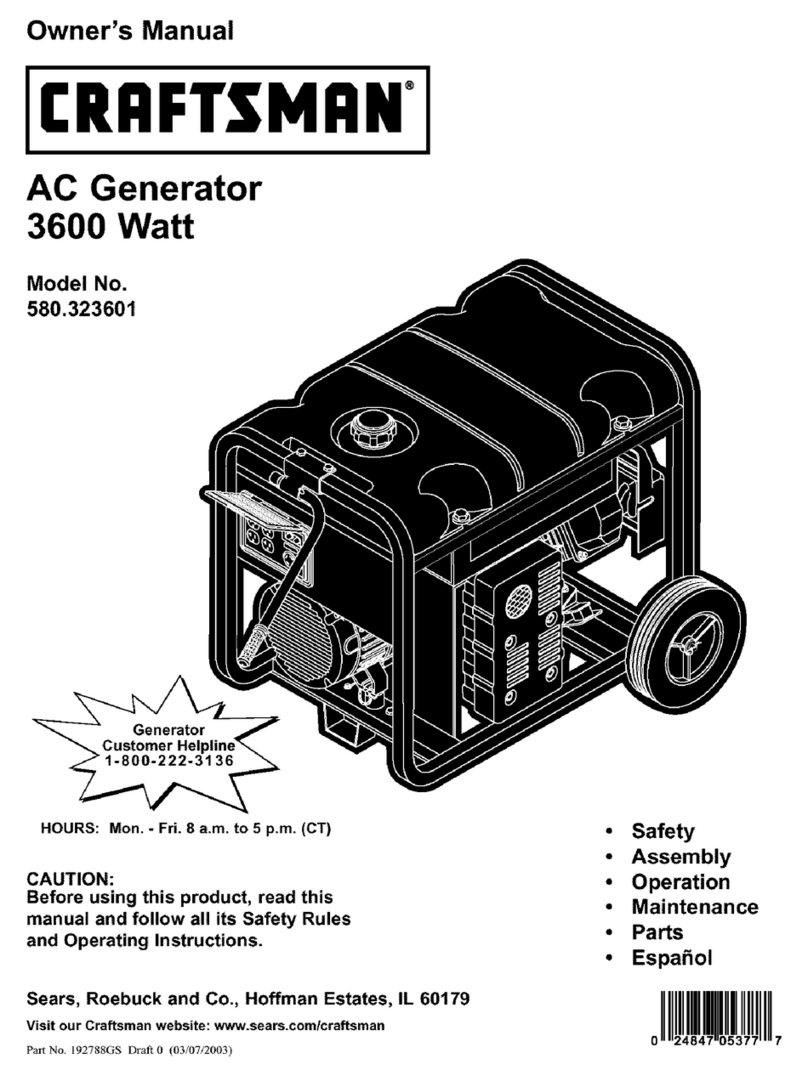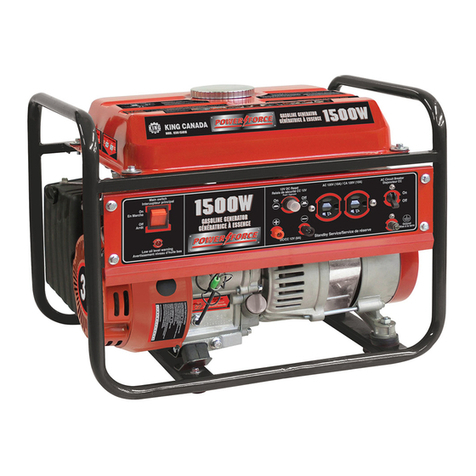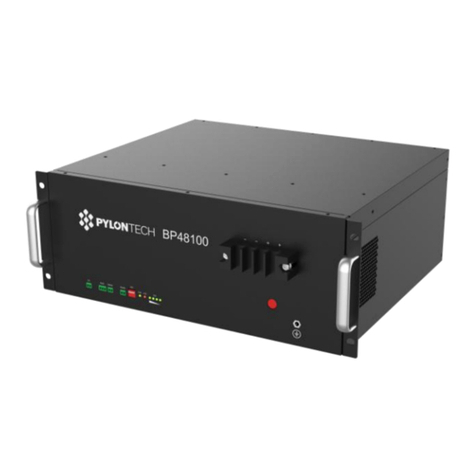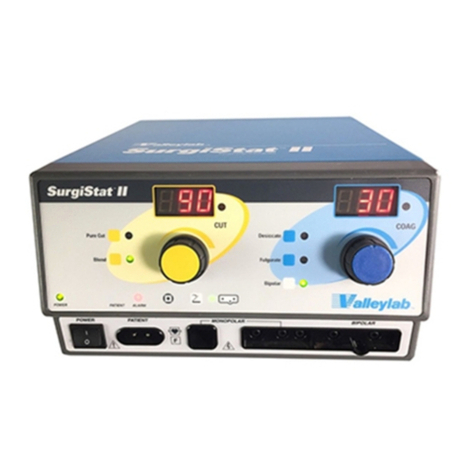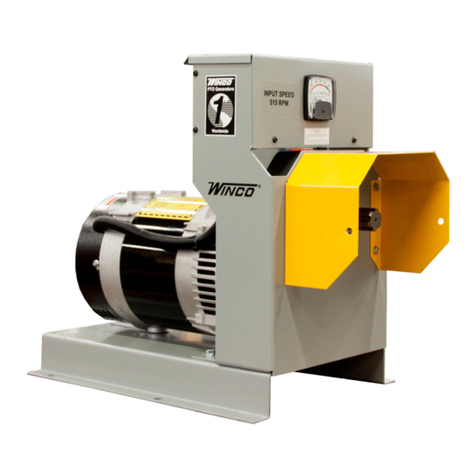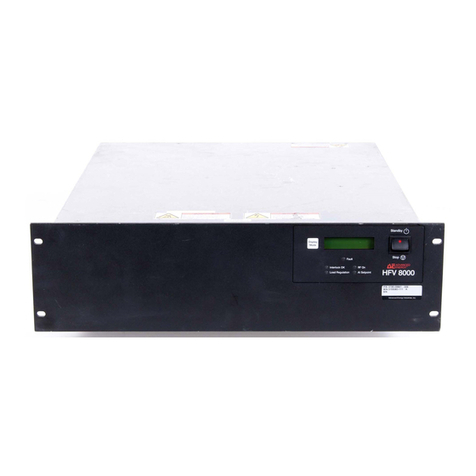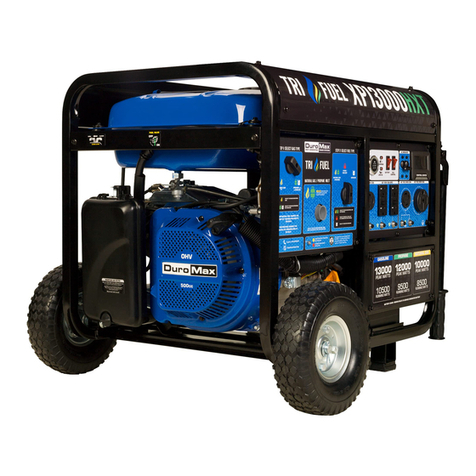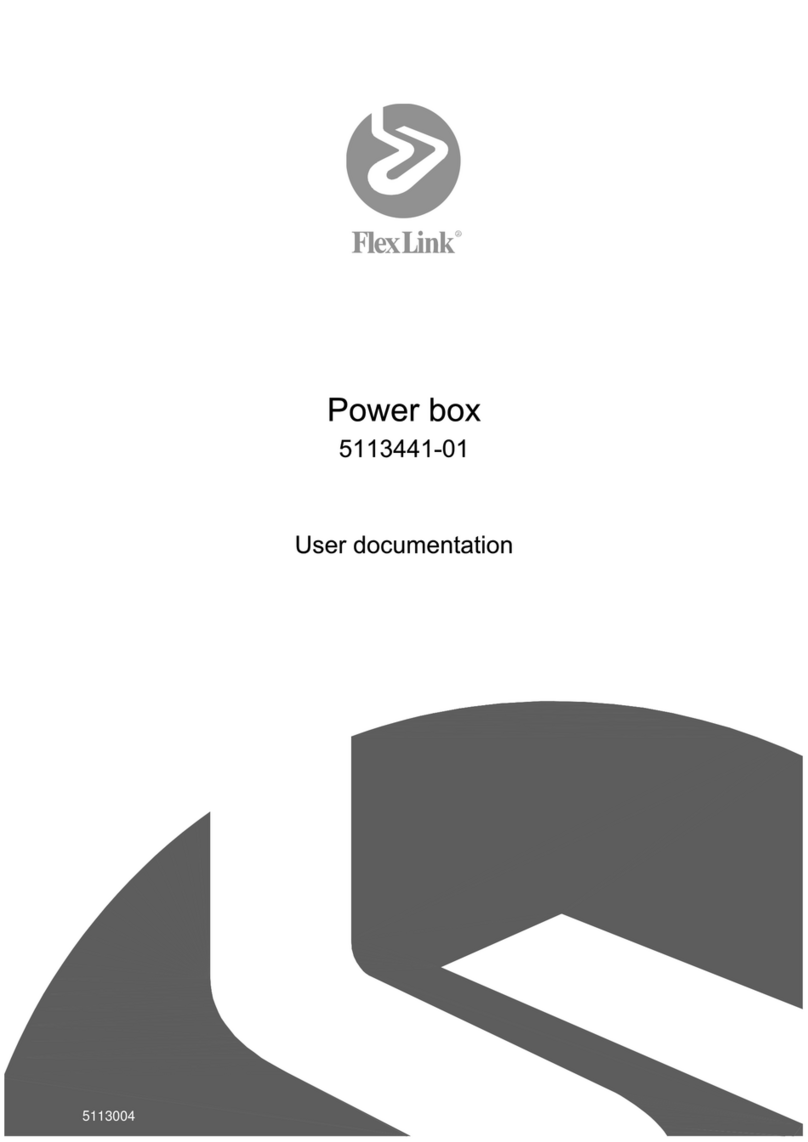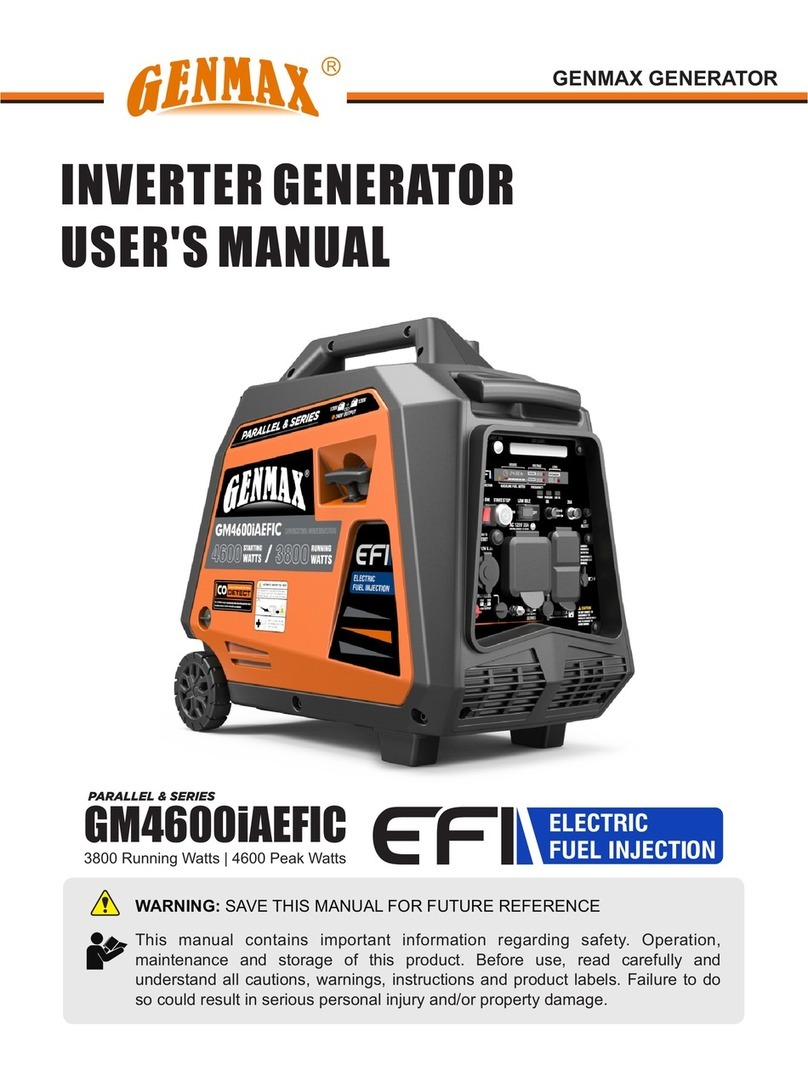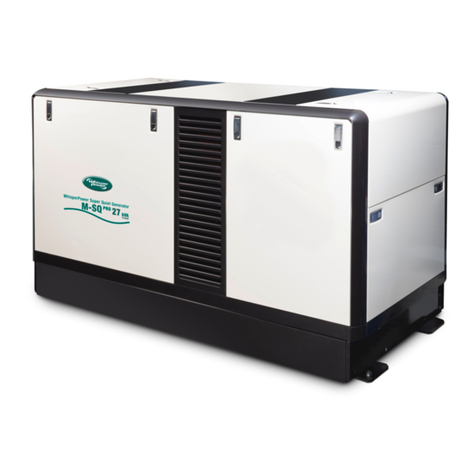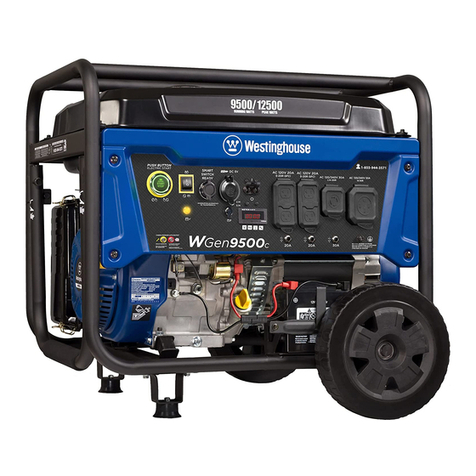Governors America DDM-101 User manual

1
Governors America Corp. © 2020 Copyright All Rights Reserved
DDM101 Dual Driver Module 6-2020-A4 PIB4134
DDM101
Dual Driver Module
The DDM101 is an dual actuator accessory module used to support
fuel and exhaust temperature balancing adjustments to both banks of
the engine, enabling each bank to receive the same amount of fuel to
produce the same amount of power, safely.
This module is primarily installed with two actuators to support a
single engine with two independent diesel fuel injection pumps or two
gaseous throttle body actuators (ATB). It is controlled with a single
GAC electronic speed controller (ESD). Thermocouple sensors
are required to gather the exhaust information used to balance the
engine.
Recommended electronic speed controllers are listed in Table 1.
Recommended actuators are listed in Table 2.
1
2
INTRODUCTION
SPECIFICATIONS
POWER INPUT
DC Input Voltage 18 - 32 V DC (Nominal 24 V DC)
Transient protected to +/-250 V DC
Actuator 1 Current Up to 15 A, Short Circuit protected
Actuator 2 Current Up to 15 A, Short Circuit protected
PWM Drive from
Speed Controller
550 Hz MIN from 12 - 32 V DC
MAX amplitude
Actuator Position Sensors 5 V DC excitation
1 to 4 V DC output
MODEL DESCRIPTION
ESD5111 Standard Electronic Speed Controller
ESD5221 Single Element Speed Switch / 10 A Relay Output
TABLE 1: RECOMMENDED GAC SPEED CONTROLLERS
ACTUATOR DESCRIPTION
ATB T1F Series 25mm to 40mm Bore Size / 12 or 24 V DC / Packard Connector / Sealed to 5.0 Bar
ATB T2F Series 45mm to 65mm Bore Size / 12 or 24 V DC / Packard Connector / Sealed to 5.0 Bar
ATB T3F Series 75mm Bore Size / 12 or 24 V DC /Packard Connector / Sealed to 5.0 Bar (Also T4)
ATB T4F Series 75mm to 95mm Bore Size / 12 or 24 V DC / Packard Connector / Sealed to 5.0 Bar
ADD175F* Bosch ‘P’ 3000 - 7000 Fuel Injection Pump/ 12 or 24 V DC/ Right hand Rack/ Packard Connector
ADD176AF Bosch ‘A’ Size Fuel Injection Pump/ 12 or 24 V DC/ Left Hand Rack/ Packard Connector
ACE275K Bosch ‘P’ 3000 - 7000 Fuel Injection Pump/ 24 V DC/ Heavy Duty Bearing Retention/ Packard Connector
ACE295F-24 Bosch ‘P’ 9000 - 10,000 Fuel Injection Pump/ 24 V DC/ Packard Connector with Mating Connector
TABLE 2: RECOMMENDED GAC FEEDBACK SENSOR EQUIPPED ACTUATORS
ENVIRONMENTAL
Operating Temperature -40 to +85 °C [ -40 to 185 °F]
Humidity up to 100 %
RELIABILITY
Vibration 1 g, 20 - 100 Hz
Shock 10 gf [11 msf]
EMC CE EN55011, EN50081-2,
and EN50082-2
* Recommended for the Cummins QST30 upgrade.

2
Governors America Corp. © 2020 Copyright All Rights Reserved
DDM101 Dual Driver Module 6-2020-A4 PIB4134
3DDM101 INSTALLATION
The DDM101 is designed to equally drive two feedback-equipped electric actuators so that each engines bank or cylinder group receives
equal fuel levels. To equalize the fuel to each cylinder bank the DDM101 has two advanced features, fuel and exhaust temperature
balance. Two exhaust temperature probes are also required.
Each actuator driver circuit has its own GAIN [ACT 1 and ACT 2] adjustment to optimize the feedback control loop response. The
actuators should be of similar types with similar position sensors with equal outputs. GAC approved actuators are listed in Table 2.
The Wiring section of this guide details available connections. DDM101 was designed to work with and electronic speed controller
(ESD) and references the ESD5111 terminal callouts.
When mounting the DDM101 attach it to a vertical surface to prevent any moisture from collecting on the circuit board. The normal
precautions outlined in the related ESD manual should be followed for the DDM101 as well.
An overspeed shutdown device, independent of the governor system, should be provided to prevent loss of engine
control which may cause personal injury or equipment damage. Do not rely exclusively on the governor system
electric actuator to prevent overspeed. A secondary shuto device, such as a fuel solenoid must be used.
Mount in a cabinet,
engine enclosure, or
sealed metal box. Ensure
adequate ventilation for
cooling.
Vertical orientation allows
for the draining of uids in
moist environments.
Avoid extreme heat.
Do not mount next to
turbocharger, exhaust
manifold, or other high
temperature equipment.
Do not mount on engine.

3
Governors America Corp. © 2020 Copyright All Rights Reserved
DDM101 Dual Driver Module 6-2020-A4 PIB4134
The DDM101 works with the specied ESD models. Placement should allow for wiring between both controllers as shown here. The com-
plete wiring diagram in the Wiring section of this guide shows all the wiring options. The following diagram shows the most common setup.
3DDM101 INSTALLATION (CONTINUED)
DDM101 TO ESD5111 INSTALLATION AND PLACEMENT

4
Governors America Corp. © 2020 Copyright All Rights Reserved
DDM101 Dual Driver Module 6-2020-A4 PIB4134
1. Determine placement of the thermocouples:
a. Locate the exhaust temperature probe in the engine exhaust outlet as near as possible to the point where all of the
cylinders merge. Alternatively, the sensor can be placed in the manifold outlet pipe.
b. Thermocouples measure temperatures at their tip. The tip should be placed in the center of the exhaust stream to ac-
curately measure the hottest point. The exhaust gas exits the thermocouple cylinder in a conical, ame, shape, with the
center of the shape being the hottest and a potential 200° dierence from the center of the ame to the edge.
2. Drill and weld bung the installation hole.
3. Dry t the sensor. Ensure the tip of the probe is well within the outlet exhaust ow.
4. Apply thread sealant to the sensor.
5. Mount the sensor using a NPT tting.
6. Thread the sensor nger tight plus two full turns.
Engine power is balanced by measuring the exhaust gas temperature reading at each bank.
The exhaust temperature probe is located in the engine exhaust outlet as near as possible to the point where all of the cylinders
merge. Alternatively, the sensor can be placed in the manifold outlet pipe. A weld bung or tapped hole must be used and care should
be taken such that the tip of the probe is well within the outlet exhaust ow. The sensor is mounted using a 1/8 in NPT tting. Drill
and tap the determined mounting location using the provided dimensions.
Exhaust Gas Temperature Sensor
GAC PN STE101: Type K Thermocouple
with 1200 °F (650 °C) Maximum.
Mating Connector is included.
4EXHAUST GAS TEMPERATURE SENSORS INSTALLATION
When using thermocouples, if the cabling length must be extended, use the same type grade thermocouple wire
to prevent temperature compensation errors. Contact your GAC contact for details on the cabling recommenda-
tions.
• Use caution installing thermocouples as they are easily damaged.
• Use Type-K wire and connectors only.
• Do not mix dissimilar metals.
Using the mounting hardware included in the STE101 kit, install one thermocouple in each exhaust gas stream.
THERMOCOUPLE TEMPERATURE SENSOR INSTALLATION PROCEDURE
TYPE K THERMOCOUPLE

5
Governors America Corp. © 2020 Copyright All Rights Reserved
DDM101 Dual Driver Module 6-2020-A4 PIB4134
5WIRING (CONTINUED)
The DDM101 works in tandem with a speed control unit. The following wiring diagram and specic wiring sections detail the DDM101
capabilities. Wiring details use the ESD5111 as the basis for terminal callouts. Check your speed controller wiring for conrmation of
terminal.
DDM101 TO ESD5111 WIRING DIAGRAM

6
Governors America Corp. © 2020 Copyright All Rights Reserved
DDM101 Dual Driver Module 6-2020-A4 PIB4134
5WIRING (CONTINUED)
DDM101 WIRING DIAGRAM
When connecting an ESD to the DDM101 ensure the actuator voltage driver type uses a PWM output and not a current driver output.
In normal actuator usage with a GAC ESD one side of the actuator is typically at near ground level voltage.
1. Connect Terminal B on the ESD (the low side of the actuator drive) to Terminal 26 on the DDM101.
2. Connect Terminal A on the ESD (the high side output of the actuator) to Terminal 25 on the DDM101.
3. Install a jumper between Terminals 9 and 10 on the DDM101.
Before wiring the actuators to the DDM101, determine if droop will be used.
NO DROOP REQUIRED
1. If droop is not required, connect the actuators as shown in this section WIRING diagram directly to the DDM101.
2. Install jumper between Terminal 9 and 10 on the DDM101.
DROOP REQUIRED
If your application requires droop, then the current in Actuator 1 is best suited for the droop signal.
1. Disconnect Terminal 26 on the DDM101 from Terminal B on the ESD
.
2. Connect Terminal 3 the minus (-) of Actuator 1 on the DDM101 to Terminal B on the ESD.
3. Connect Terminal 3 on the DDM101 to Terminal E on th ESD.
4. Adjust droop proportional to the current in Actuator 1, on the ESD. See your speed control unit’s manual for droop adjustment
details.
FOR PROPORTIONAL DROOP
If the application requires that droop be proportional to Actuator 2:
1. Remove the jumper from DDM101 Terminals 9 and 10.
2. Disconnect Terminal 26 on the DDM101 from Terminal B on the ESD.
3. Connect Terminal 10 on the DDM101 to Terminal B on the ESD.
4. Connect Terminal 9 of the DDM101 to Terminal E on the ESD.
CONNECTING TO AN ESD
CONNECTING DDM101 TO THE ACTUATORS

7
Governors America Corp. © 2020 Copyright All Rights Reserved
DDM101 Dual Driver Module 6-2020-A4 PIB4134
5WIRING (CONTINUED)
Each position sensor cable should be three-wire shielded type with the shields connected only to the case on the DDM101.
The actuator feedback sensor (AB feedback sensor type) is a three, sensor-terminated wire with an AMP connector, (Table 3.) for
accessory parts.
For proper connection from the feedback sensor or the cable harness to the DDM101 (Table 4).
Case ground (right or left corner screw) should be connected to battery minus (Terminal 7) with a separate cable for the best EMC
ratings.
Cables used on the terminals for Actuator 1 or 2 handle full actuator current, therefore they must be sized properly to handle the
current (Table 5).
ACTUATOR
POSITION SENSOR
MATING CONNECTOR
POSITION SENSOR
MATING HARNESS
ADD175F-12/24 EC1523 CH1243
ADD176AF-12/24 EC1515 CH1515
ACE275K EC1515 CH1515
ACE295F-24 EC1515 CH1515
ATB T1 Series EC1523 CH1243
ATB T2 Series EC1515 CH1515
ATB T3 Series EC1515 CH1515
ATB T4 Series EC1523 CH1243
TABLE 3: ACCESSORIES
TABLE 5: CONNECTION - FEEDBACK SENSOR / CABLE HARNESS
CONNECTION
Position Sensor
Connector
Harness
CH1515
Harness
CH1243 DDM101
Signal Number Color Number Color Pin Color Act 1 Act 2
+5V 1 Red 1 Red A Red 15 (+) 22 (+)
GND 2 Black 2 Black B Black 13 (-) 20 (-)
Out 4 White 4 White C White 14 (‹) 21 (‹)
RECOMMENDED WIRE SIZE
ACTUATOR RECOMMENDED WIRE SIZE
FOR TYPICAL APPLICATION*
ATB Series: T1F/T2F/T3F/T4F 14 AWG
ADD175F 16 AWG
ADD176AF 16 AWG
ACE275K 16 AWG
ACE295F-24 16 AWG
*Compensation for length and temperature will aect wire size.
TABLE 4: WIRE SIZE
POSITION SENSOR WIRING GENERAL INFORMATION

8
Governors America Corp. © 2020 Copyright All Rights Reserved
DDM101 Dual Driver Module 6-2020-A4 PIB4134
6PRE ENGINE-START ADJUSTMENTS
Before starting the engine, check and/or restore potentiometer values to the factory settings.
FACTORY SETTING OF THE POTENTIOMETERS
Potentiometer Type Setting
ACT 1
Gain 270˚ Turn 30˚
Stability 270˚ Turn 50˚
Thermocouple 270˚ Turn 50˚
ACT 2
Gain 270˚ Turn 30˚
Stability 270˚ Turn 50˚
Thermocouple 270˚ Turn 50˚
GAIN
Temp Balance 270˚ Turn 50˚
Governor 270˚ Turn 30°
Fuel Balance 25 Turn 12 Turns CW
TABLE 6: DDM101 FACTORY SETTINGS
Each actuator driver circuit has its own actuator GAIN [ACT 1 and ACT 2] adjustment on the DDM101 to optimize the feedback control
loop response.
1. Adjust ACT 1 and ACT 2 as high as possible without developing engine or actuator instability.
a. Adjust Actuator 1 by rotating the ACT 1 GAIN potentiometer CW until instability develops.
b. Gradually move the adjustment CCW until stability returns. Move the adjustment 1/8 of a
turn CCW to ensure stable performance.
c. Adjust the ACT 2 GAIN potentiometer following the same steps as for Actuator 1.
d. Poke or disturb the actuator to try to induce instability.
e. On the speed controller, adjust the GAIN and STABILITY adjustments for best response
from the actuators.
The SPEED and GAIN adjustment on the ESD and the GAIN [ACT 1 and ACT 2] adjustments on the DDM101 can have some interaction.
It is possible to turn one up and the other down and get similar results. The GAIN adjustments on the DDM101 must not be turned to low
or speed control performance may suer. A mid-range setting or higher for all of the GAIN adjustments is recommended.
With power applied to the DDM101 and before starting the engine, measure the voltage at the Terminals 16(+) and 17(-).
To monitor rack position, using a multimeter, apply voltage to the DDM101 but before starting the engine, measure the voltage at Terminals
16(+) and 17(-).
1. Adjust voltage to zero volts at the Actuator 1 Oset (A1 O) for Actuator 1
(closed position) and Terminals 18(+) and 19(-) at the Actuator 2 Oset (A2
O).
2. At maximum position the voltage at the Terminals 16 - 19 should be 1 V and
can be adjusted using Actuator 1 Gain (A1 G) and Actuator 2 Gain (A2 G)
respectively.
3. To manually open the actuator, remove the wire from Terminal A on the ESD
and connect the wire to Terminal F on the ESD.
4. Adjust A1 G and A2 G for 1 V output at Terminal 16 and Terminal 18.
5. Reconnect the wire to Terminal A on the ESD.
Some mechanical calibration of the actuator linkage and the fuel rack is required usually at idle fuel or a mid point at load control. With the
engine running, stable operation should be achieved by properly adjusting the ESD and the altering the following on the DDM.
Start the engine and follow the setup procedure outlined in the ESD user guide. After starting the engine, the following adjustments can
be made.
7ENGINE ADJUSTMENTS
ADD POSITION LOOP GAIN
RACK POSITION CALIBRATION

9
Governors America Corp. © 2020 Copyright All Rights Reserved
DDM101 Dual Driver Module 6-2020-A4 PIB4134
The FUEL BALANCE adjustment allows for equalization of the fuel being delivered by each
actuator. The FUEL BALANCE adjustment is set to equal engine cylinder power at near
100 % of engine load. To achieve the minimum dierence at any load point the mechanical
linkage adjustments should be set equal at 20 % power, with the electrical adjustments set equal
at 80 % power.
1. With the engine running at no load, using a multimeter, measure the DC voltage output of the
feedback sensors from each actuator.
• Voltage measurement for Actuator 1 is taken across Terminals 13 and 14.
• Voltage measurement for Actuator 2 is taken across Terminals 20 and 21.
2. Both voltage measurements should have an operational range of 1 to 4 V DC.
3. If the voltage readings are not equal, adjust the FUEL BALANCE potentiometer on the
DDM101 until the voltage readings are equalized and the exhaust temperatures are
balanced.
Any dierences noted by the actuator position sensors is nullied by the electronics so that
the position sensors track equally throughout the range, unless compensated with the FUEL
BALANCE adjustment on the DDM101.
Each actuator has its own actuator stability ACT 1 STABILITY and ACT 2 STABILITY adjustment to optimize system stability. Adjust both
ACT 1 and ACT 2 STABILITY adjustments as high as possible without engine or actuator instability.
1. Adjust Actuator 1 rst by rotating the ACT 1 STABILITY adjustment CCW until instability in the
engine develops.
2. Gradually move the adjustment CW until stability returns. Move the adjustment 1/8 of a turn CW to
ensure stable performance.
3. Adjust Actuator 2 via the ACT 2 STABILITY adjustment following the same steps as for Actuator 1.
4. Poke or disturb the actuator to induce instability. Adjust the GAIN and STABILITY for best response
of the actuator.
ACTUATOR STABILITY ADJUSTMENT
FUEL BALANCE ADJUSTMENTS
With the engine running at rated speed, adjust gain and stability (PID) at the ESD or the DDM101 for optimum performance.
Adjusting the ESD, see your speed control unit’s manual for details on the following:
• For best performance, ESD gain adjustment should be set between 40 - 60 % of range.
• If the ESD GAIN adjustment is below 25 % the DDM101’s GAIN adjustment should be rotated CCW to a lower setting.
• Readjust the ESD PID settings for optimum transient performance (See your speed control unit’s
manual).
Adjusting the DDM101 can also be accomplished by analyzing the ESD PWM voltage input to Terminals 25
and 26 on the DDM101. Using a multimeter check the following:
• The voltage between Terminals 25 and 26 should measure 7 V DC at no load and 14 V DC at full load.
• If the measured voltage is lower than the desired range, the DDM101’s GAIN GOVERNOR adjustment
is set too high and should be rotated counter-clockwise to a lower setting. This should increase the
voltage across Terminals 25 and 26 on the DDM101.
• If the measured voltage is lower than the desired range, the DDM101 GAIN GOVERNOR adjustment is
set too low and should be rotated clockwise to a higher setting. The voltage across Terminals 25 and
26 on the DDM101 should decrease.
GAIN ADJUSTMENT
7ENGINE ADJUSTMENTS (CONTINUED)

10
Governors America Corp. © 2020 Copyright All Rights Reserved
DDM101 Dual Driver Module 6-2020-A4 PIB4134
LED FUNCTION
ACT 1 Actuator drive circuit 1 is receiving a drive signal from the controller.
ACT 2 Actuator drive circuit 2 is receiving a drive signal from the controller.
TC 1 FAULT Thermocouple 1 has a fault or open circuit.
TC 2 FAULT Thermocouple 2 has a fault or open circuit.
EXHAUST TEMP 1 Unbalanced exhaust temperatures; control is actively trimming fuel to actuator 1 to
balance the system.
EXHAUST TEMP 2 Unbalanced exhaust temperatures; control is actively trimming fuel to actuator 2 to
balance the system.
GOV DRIVE Drive signal from external speed controller is being removed to open up the throttle.
TABLE 7: LED LIGHTS
The DDM101 requires the use of exhaust temperature thermocouples to balance the load precisely with the dynamic balancing function.
Placement of thermocouples in the exhaust gas stream does not guarantee that equal measurements provide equal power from each
bank. Exhaust temperature is, however, a good indication of balance and the exhaust temperature control loop will actively trim the
system.
With two industrial rated Type K type thermocouples installed in the exhaust pipe of each bank the DDM101 can measure and track two
exhaust temperatures.
• The thermocouple adjustments (THERMOCOUPLE 1 and THERMOCOUPLE 2) are calibrated at
the factory to receive equal input signals from the thermocouples.
• If a dierence in either bank’s exhaust temperature is measured by the DDM101, the control loop
will readjust the fuel balance automatically to minimize the dierence.
• If a measured dierence is still found, the operator can manually reduce the unbalance and
increase the temp control loop authority by a CW rotation of the TEMP. BAL GAIN adjustment.
If at any time, one or both of the thermocouples signals are lost (open circuit detected) the TC 1 or TC 2 fault LED will light and the
balancing function will shut o (Table 7).
Do not alter the factory settings of THERMOCOUPLE 1 or THERMOCOUPLE 2 adjustments unless a signicant imbalance
exists.
If an imbalance occurs rst try to correct the issue using the standard mechanical and electronic balancing methods
described previously. If a problem persists determine which exhaust channel is higher in temperature and adjust the
bank’s THERMOCOUPLE adjustment counter-clockwise to equalize the exhaust temperature. Adjusting the cooler banks
THERMOCOUPLE adjustment clockwise may also equalize the exhaust temperature.
EXHAUST TEMPERATURE DIFFERENCE MONITORING AND CONTROL
7ENGINE ADJUSTMENTS (CONTINUED)

11
Governors America Corp. © 2020 Copyright All Rights Reserved
DDM101 Dual Driver Module 6-2020-A4 PIB4134
GENERAL ISSUE POSSIBLE SOLUTION
Insucient
magnetic speed
signal
• A strong magnetic speed sensor signal eliminates missed or extra pulses. The speed control unit will gov-
ern well with 1.0 V AC speed sensor signal. A speed sensor signal of 3 volts V AC or greater at governed
speed is recommended.
• Measure signal at Terminals C and D.
• To raise the amplitude of the speed sensor signal, reduce the gap between the speed sensor tip and the
engine ring gear. The gap should not be < 0.025 in (0.64 mm). When the engine is stopped, back the speed
sensor out by 1/4 turn after touching the ring gear tooth to achieve a satisfactory air gap.
Thermocouples
not responding
If one or both of the thermocouple signals are lost (open circuit detected) the TC 1 or TC 2 fault LED will light
and the balancing function will shut o. Do not alter the thermocouple factory settings.
• Adjust the TEMP. BAL GAIN potentiometer on the DDM101.
• If a problem persists:
• Determine which exhaust channel is higher in temperature and adjust the bank’s THERMOCOUPLE
adjustment counter-clockwise to equalize the exhaust temperature.
• Adjust the cooler banks THERMOCOUPLE adjustment clockwise to equalize the exhaust temperature.
• Examine protection tubes for excessive corrosion, wear, oxidation and physical damage. Protection tubes
exhibiting damage and/or excessive corrosion should be replaced.
• Examine wiring for damaged insulation and tight connection points.
System
inoperative
• Positive (+) and negative (-) refer to meter polarity. Should normal values be indicated during trouble-
shooting steps, and then the fault may be with the actuator or the wiring to the actuator.
• Tests are performed with battery power on and the engine o, except where noted.
• See your GAC representative for additional help for inoperative system issues after reading this manual.
System
inoperative
F(+) and E(-) Battery Supply
Voltage
(12 or 24 V DC)
• DC battery power not connected. Check for blown fuse.
• Low battery voltage.
• Wiring error.
System
inoperative
C(+) and D(-)
1.0 V AC minimum
while cranking
• Gap between speed sensor and gear teeth too great. Check Gap.
• Improper or defective wiring to the speed sensor. Resistance between
D and C should be 160 to 1200 ohms. See specic mag pickup data for
resistance.
• Defective speed sensor.
System
inoperative
P(+) and G(-)
10 V DC, Internal Supply
Short on Terminal P.
Defective speed control unit.
System
inoperative
F(+) and A(-)
1.0 - 2.0 V DC while cranking
• SPEED parameter set too low.
• Short/open in actuator wiring.
• This may be a defective speed control. See your GAC representative for
more information.
Instability:
The engine jitters
at 3Hz or faster.
Fast Periodic
• Turn o other electrical equipment that may be causing interference.
Readjust the GAIN and STABILITY for optimum control.
• Remove the E6 to E7 jumper to reduces sensitivity to high frequencies.
• If system is still unstable, remove the E1 to E2 jumper and readjust
GAIN and STABILITY.
Instability: Irreg-
ular speed below
3Hz
Slow Periodic
• Readjust the GAIN and STABILITY.
• Set DIP switches 1 and 2 to “ON” in the following order: First SW1,
Second SW2.
• Check fuel system linkage during engine operation for:
• binding
• high friction
• poor linkage
• Adjust the DEAD TIME COMPENSATION on the DDM101 by adding a
capacitor from posts E2 to E3 (negative on E2). Start with 10 mfds.
8TROUBLESHOOTING

12
Governors America Corp. © 2020 Copyright All Rights Reserved
DDM101 Dual Driver Module 6-2020-A4 PIB4134
GENERAL ISSUE POSSIBLE SOLUTION
Instability: erratic
engine behavior
Non-Periodic
Increasing the GAIN should reduce the instability but not
totally correct it.
If this is the case, there is most likely a problem with the
engine itself.
Check for:
• engine mis-rings
• an erratic fuel system
• load changes on the generator set voltage regulator.
If throttle is slightly erratic, but performance is fast, then re-
move the jumper from E6 to E7.
Unsatisfactory
performance:
engine overspeed
Do Not Crank. Apply DC power to the gover-
nor system.
After the actuator goes to full fuel, disconnect the speed
sensor at Terminals C and D. If the actuator is still at full
fuel-speed then the speed control unit is defective.
Unsatisfactory
performance
Manually hold the engine at the desired run-
ning speed.
Measure DC voltage between Terminals A(-)
and F(+) on the speed control unit.
If the voltage reading is 1.0 to 2.0 V DC:
• SPEED adjustment is set above desired speed
• Defective speed control unit
• If voltage reading is above 2.0 V DC then check for:
• actuator binding
• linkage binding
• Set point of overspeed shutdown device set too low.
• If the voltage reading is below 1.0 V DC most probably a
defective speed control unit. Call GAC.
Overspeed shuts
down engine
after running speed
reached
• Speed adjustment set too high.
• OVERSPEED set to close to running speed.
• Actuator or linkage binding.
• Speed control unit defective.
Actuator does not
energize fully
Measure the voltage at the battery while
cranking.
If voltage is less than 7 V DC for a 12 V DC system, or 14 for
a 24 V DC system, check or replace the battery.
Overspeed shuts
down engine
Momentarily connect Terminals A and F. The actuator should move to the full fuel position.
• Actuator or battery wiring in error
• Actuator or linkage binding
• Defective actuator
• Fuse opens. Check for short in actuator or harness.
Engine remains
below desired gov-
erned speed
Measure the actuator output, Terminals A
and B, while running under governor control.
If voltage measurement is within 2 V DC of the battery supply
voltage level, then fuel control is restricted from reaching full
fuel position, possibly due to mechanical governor, carburetor
spring, or linkage interference.
SPEED parameter set too low.
8TROUBLESHOOTING (CONTINUED)
Other manuals for DDM-101
2
Table of contents
